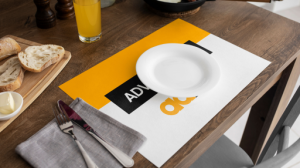As marketers strive to discover innovative advertising mediums, the humble placemat has emerged as an unconventional yet impactful option. Placed directly in front of a captive audience during meal times, placemats offer an opportunity to deliver high-impact, hyper-targeted marketing messages. But what makes advertisement on placemats so effective? The answer lies in the psychological and behavioral tendencies of consumers.
This blog explores how placemats captivate attention, influence behavior, and drive customer engagement, while providing practical strategies for making the most of this overlooked advertising platform.
Why Advertisement on Placemats Works
Captive Audience Effect 
One of the key reasons why advertisement on placemats is effective lies in its ability to hold the attention of a captive audience. While waiting for their meals or dining, patrons naturally focus on the placemat in front of them. With no competing distractions, placemats become prime real estate for advertisements.
Psychological Insight
Unlike digital ads that are often skipped or ignored, placemat ads take advantage of uninterrupted dwell time. The average customer spends between 20-30 minutes at a table, providing ample time for the message to sink in.
Repetition and Recall
Frequent exposure to an ad enhances memory recall, a concept known as the mere exposure effect. Placemats, which remain in sight for the duration of the meal, reinforce brand messaging multiple times during a single interaction.
Strategies for Effective Placemat Advertising
Creative Visuals and Messaging: An engaging design is critical to capturing and retaining attention. Use bold colors, compelling images, and concise copy to make your advertisement visually appealing. Including a clear call-to-action (CTA) ensures that customers know exactly what steps to take next.
Pro Tip: Incorporate humor or puzzles to increase engagement. A witty tagline or a simple crossword related to your product keeps patrons entertained and focused on your ad.
Interactive Elements: Adding interactive components to your placemat ad enhances user engagement. QR codes, for example, can lead customers to product pages, discount coupons, or brand videos.
Case Study: A restaurant chain featured a QR code on placemats that directed diners to a feedback form. Not only did this increase customer interaction, but it also provided valuable insights into customer preferences.
Localized Campaigns: Placemat advertising is particularly effective for hyper-local campaigns. Small businesses like gyms, cafes, or community event organizers can use this medium to target nearby audiences with promotions or announcements.
Example: A local real estate agent uses placemats in neighborhood diners to advertise open house events, reaching potential buyers directly within the community.
Behavioral Psychology: How Placemats Influence Customer Actions
 1. The Power of Context: Advertisement on placemats benefits from the context in which it is placed. Dining is an activity associated with comfort and leisure, creating a relaxed state of mind that makes patrons more receptive to advertising messages.
1. The Power of Context: Advertisement on placemats benefits from the context in which it is placed. Dining is an activity associated with comfort and leisure, creating a relaxed state of mind that makes patrons more receptive to advertising messages.
2. Priming Purchase Decisions: Ads promoting related products or services can influence immediate decisions. For example, a placemat ad featuring a dessert promotion at the same restaurant can prompt diners to order dessert after their meal.
Research Insight: Studies show that contextually relevant ads are 27% more effective in driving consumer action compared to generic ads.
3. Trust by Association: Advertising in a familiar environment, like a favorite diner or restaurant, lends credibility to the brand. Patrons are more likely to trust and engage with ads when they are associated with trusted establishments.
Examples of Industries Leveraging Placemat Advertising
1. Healthcare:
A healthcare provider uses placemats to promote flu shots during the fall season. The ad includes a QR code for appointment scheduling, leading to increased bookings.
2. E-commerce:
An online retailer promotes first-time buyer discounts on placemats in family-friendly restaurants. A scannable QR code redirects diners to the retailer’s website, boosting new customer acquisitions.
3. Financial Services:
A credit counseling agency advertises free workshops on placemats in local diners. Customers scan a QR code to register, resulting in higher attendance rates and improved brand awareness.
4. Entertainment:
A movie studio advertises upcoming releases with QR codes linking to trailers and exclusive behind-the-scenes content. Placemats in cinemas and cafes serve as the perfect platform to build anticipation.
Measuring the Effectiveness of Placemat Advertising
 Reach and Impressions The number of diners per restaurant multiplied by the campaign duration provides a clear estimate of total impressions. Restaurants with 300-500 daily visitors can generate thousands of views over a month-long campaign.
Reach and Impressions The number of diners per restaurant multiplied by the campaign duration provides a clear estimate of total impressions. Restaurants with 300-500 daily visitors can generate thousands of views over a month-long campaign.
Cost-Effectiveness Placemat advertising offers a low cost-per-thousand impressions (CPM) compared to digital and traditional outdoor advertising. This makes it an affordable yet impactful option for businesses of all sizes.
Engagement Tracking QR codes, promo codes, or unique landing page URLs provide measurable insights into campaign performance. Metrics like clicks, redemptions, and conversions highlight the success of your advertising efforts.



 1. The Power of Context:
1. The Power of Context: Reach and Impressions
Reach and Impressions



